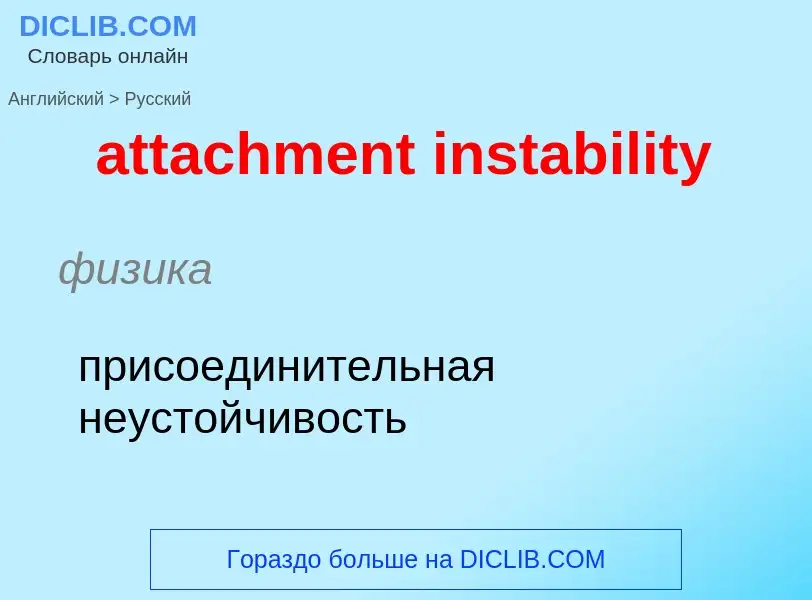Translation and analysis of words by ChatGPT artificial intelligence
On this page you can get a detailed analysis of a word or phrase, produced by the best artificial intelligence technology to date:
- how the word is used
- frequency of use
- it is used more often in oral or written speech
- word translation options
- usage examples (several phrases with translation)
- etymology
attachment instability - translation to russian
физика
присоединительная неустойчивость
общая лексика
самовольное подключение к сети оборудования
Definition
Wikipedia
Attachment disorder is a broad term intended to describe disorders of mood, behavior, and social relationships arising from unavailability of normal socializing care and attention from primary care giving figures in early childhood. Such a failure would result from unusual early experiences of neglect, abuse, abrupt separation from caregivers between three months and three years of age, frequent change or excessive numbers of caregivers, or lack of caregiver responsiveness to child communicative efforts resulting in a lack of basic trust. A problematic history of social relationships occurring after about age three may be distressing to a child, but does not result in attachment disorder.
The term attachment disorder is used to describe emotional and behavioral problems of young children, and also applied to school-age children, teenagers and adults. The specific difficulties implied depend on the age of the individual being assessed, and a child's attachment-related behaviors may be very different with one familiar adult than with another, suggesting that the disorder is within the relationship and interactions of the two people rather than an aspect of one or the other personality. No list of symptoms can legitimately be presented but generally the term attachment disorder refers to the absence or distortion of age-appropriate social behaviors with adults. For example, in a toddler, attachment-disordered behavior could include a failure to stay near familiar adults in a strange environment or to be comforted by contact with a familiar person, whereas in a six-year-old attachment-disordered behavior might involve excessive friendliness and inappropriate approaches to strangers.
There are currently two main areas of theory and practice relating to the definition and diagnosis of attachment disorder, and considerable discussion about a broader definition altogether. The first main area, based on scientific enquiry, is found in academic journals and books and pays close attention to attachment theory. It is described in ICD-10 as reactive attachment disorder, or "RAD" for the inhibited form, and disinhibited attachment disorder, or "DAD" for the disinhibited form. In DSM-IV-TR both comparable inhibited and disinhibited types are called reactive attachment disorder or "RAD".
The second area is linked to the use of pseudoscientific attachment therapies to treat children seen to be exhibiting "attachment disorders". These therapies are controversial and have been linked to the documented deaths of at least six children during therapy. This approach to the diagnosis and treatment of attachment disorders is considered pseudoscientific. It can be found in clinical practice, on websites and in books and publications, but has little or no evidence base. It makes controversial claims relating to a basis in attachment theory.
Some authors have suggested that attachment, as an aspect of emotional development, is better assessed along a spectrum than considered to fall into two non-overlapping categories. This spectrum would have at one end the characteristics called secure attachment; midway along the range of disturbance would be insecure or other undesirable attachment styles; at the other extreme would be non-attachment. Agreement has not yet been reached with respect to diagnostic criteria.
Finally, the term is also sometimes used to cover a third area addressing difficulties arising in relation to various attachment styles which may not be disorders in the clinical sense.

![John Guest]] of the [[Province of Pennsylvania]] John Guest]] of the [[Province of Pennsylvania]]](https://commons.wikimedia.org/wiki/Special:FilePath/Writ 1702.jpg?width=200)
